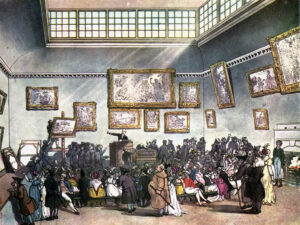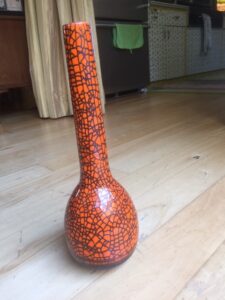What’s the State of Art and Antique Auctions Today? What Are the Key Trends?
 I received these questions from a reader who said he found NO LUCK in selling locally, and that it seemed like all the ‘actions’ in sales happened at auction. HE IS PRIMARILY RIGHT. Since COVID, sellers sent so many materials to auction that auction houses became selective.
I received these questions from a reader who said he found NO LUCK in selling locally, and that it seemed like all the ‘actions’ in sales happened at auction. HE IS PRIMARILY RIGHT. Since COVID, sellers sent so many materials to auction that auction houses became selective.
This reader sent me a series of questions. I bet my answers will help you if you’re considering an auction for sales purposes.
Q: What are the key trends and issues in the recent art market?
 We see a growing market for underrepresented artists (women, minorities, etc.) new definitions of WHAT ART IS, and to whom the definitions serve….
We see a growing market for underrepresented artists (women, minorities, etc.) new definitions of WHAT ART IS, and to whom the definitions serve….- We see regional interests keyed to certain American geographic regions; however, the auction market for regional works is national in many cases. Specific auction houses DO still exist for strong regional art. For example, John Moran in Monrovia California for California artists, and Coeur d’Alene Auctions in Idaho for Western art.
- We see new buyers, mainly under 35, for new works. The market for traditional work, landscape or historically themed art, is DOWN.
Q: Since COVID-19 the size of the art auction market has also grown rapidly. I’m sure a lot of reasons exist. Is one reason the younger generations?
 Here’s a few more reasons why the auction art market grew so rapidly:
Here’s a few more reasons why the auction art market grew so rapidly:
- Not only is the auction market stronger than ever for fine art, but the auction market is also extraordinarily strong in decorative art and midcentury modern furniture. I think of Los Angeles Modern Auctions, and Wright/Rago auctions.
- Another reason the auction market has grown: Over the pandemic, people SOLD GREAT decorative art and fine art, as well as modern furniture. The auction houses had, and still do have, so much inventory they can be selective!
- The younger generation’s interest is growing for one BIG reason: many worked from home for two to three years now, so HOME has become a central focus. Thus, fine, and good decorative art and furniture for the HOME is CENTRAL.
Q: What’s the reason for the entry of young customers into the art market?
- The main reason for young interest came during the pandemic when ALL auctions were held online, and the combination of platforms. In other words, LIVE auctioneers link small auctions with large ones. Smaller auction houses formed consortia with other auction houses (Rago and Wright merger, and Bonhams and Skinner merger) made auctions the central platform for the tech savvy young buyer.
- Specialty auctions: Many houses capture the young money by offering themed sales. For example, a ceramic sale by ONE well known ceramist from the 1960s.
Q: Can you give me any examples of young customers actually entering the art market?
Let me give you a STRONG example: A 35-year-old couple who mainly work from home are proud of their midcentury home’s architecture. They fit the art and furniture to the period of the home. Across the US that generation looks for homogenous environments…
Q: What efforts do companies, such as art auctions and art galleries, do to attract the attention of young customers?
 Auction houses court the young money by offering multiple platforms on which to buy art and decorative art. For example, Sotheby’s has the MAIN house auctions, but also offers Sotheby’s specialty platforms, similar to eBay auctions. Thus, a young couple can enter the auction market and get familiar with the process at ALL price points. Learning how to negotiate an auction is the first step, and since many of that generation are totally tech literate, and has experience with eBay, if nothing else, “learning” the auction world is totally different from MY day. I worked at Christie’s in Manhattan for a short time when all auctions were live, and a scratch on your nose while bidding could cost you a million….
Auction houses court the young money by offering multiple platforms on which to buy art and decorative art. For example, Sotheby’s has the MAIN house auctions, but also offers Sotheby’s specialty platforms, similar to eBay auctions. Thus, a young couple can enter the auction market and get familiar with the process at ALL price points. Learning how to negotiate an auction is the first step, and since many of that generation are totally tech literate, and has experience with eBay, if nothing else, “learning” the auction world is totally different from MY day. I worked at Christie’s in Manhattan for a short time when all auctions were live, and a scratch on your nose while bidding could cost you a million….
Q: Please explain when and what changes occurred in the art market, such as what happened in the auction world in the 2008 global financial crisis and the crisis of COVID-19.
 2008: the bubble burst, and since then, traditional fine art (what my grandparents owned) NEVER recovered.
2008: the bubble burst, and since then, traditional fine art (what my grandparents owned) NEVER recovered. - Similarly, during the pandemic, traditional shopping at galleries and art shows and art fairs SUNK to an all time low. This was the golden moment for the auction world! A buyer did not have to BE THERE in person to buy. Therefore, many established galleries CLOSED.
- Appraisers like myself before COVID were taught that there are TWO markets: the primary market (retail) and the secondary market (traditional AUCTION sales). NOW, the paradigm has FLIPPED. The auction market is now the MAIN market for fine art and decorative art and furniture.
Q: How do you evaluate the digital art auction market?
THE LOADED QUESTION… the main problem with NFT and digital art is the LEGAL problem. The JURY IS OUT on that. The art world is scrambling to negotiate the problems of copyright, duplicability, ownership, title, etc…
Q: Can you offer tips to people when choosing and selling artworks? How to choose a good piece of art, how to sell it at a high price, etc.?
- Go with your instinct
- Don’t rely on advice
- Don’t worry about what looks good with whatever else you may own
- Become an expert in one artist, or one medium, or one genre
- Once you become and expert on ONE small portion of the area in which you love to collect, you have a transferrable skill, in my view, the honing of AN EYE
Q: Lastly, might you predict the future changes in the global art market?
 Auctions will become stronger, and offer more tools for the buyer AND the seller. By offering special reserves for the seller and special techniques for sales, which may or may NOT be disclosed to the buyer, prices at which an object is withdrawn. Auctions will also offer post auction sale “special deals.” I predict we will see less government oversight. There’s not much oversight NOW, but I think we’ll see LESS as auctions become the only game in the art market. Legal cases around auction sales I predict will be a hot button issue.
Auctions will become stronger, and offer more tools for the buyer AND the seller. By offering special reserves for the seller and special techniques for sales, which may or may NOT be disclosed to the buyer, prices at which an object is withdrawn. Auctions will also offer post auction sale “special deals.” I predict we will see less government oversight. There’s not much oversight NOW, but I think we’ll see LESS as auctions become the only game in the art market. Legal cases around auction sales I predict will be a hot button issue.